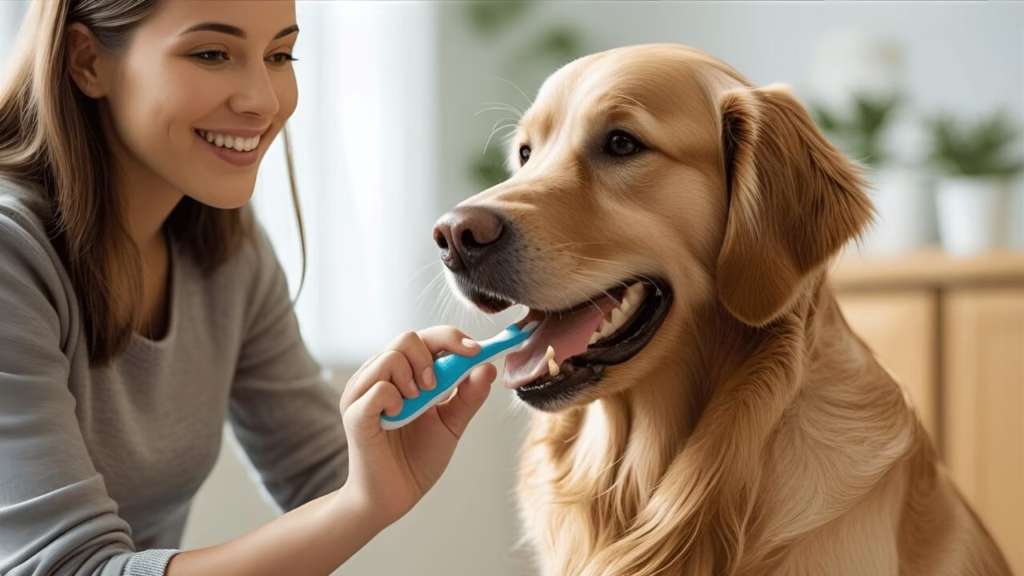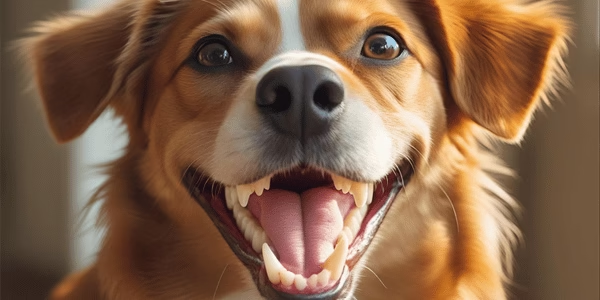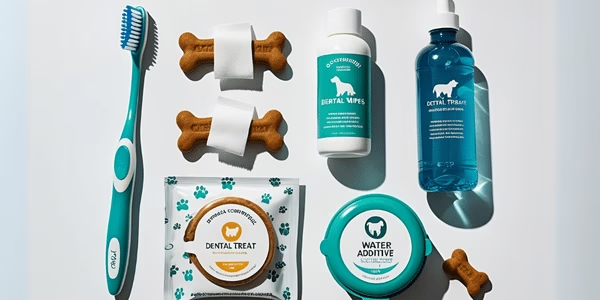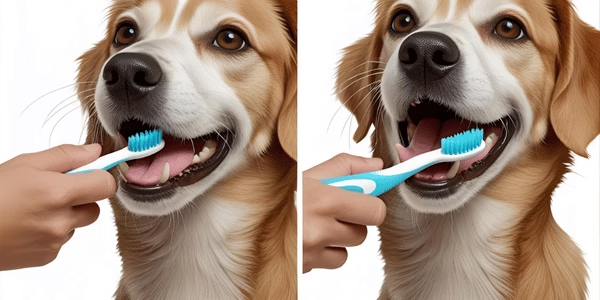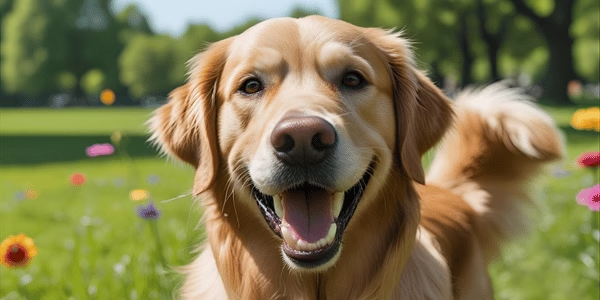Your dog’s wagging tail and happy demeanor might mask a painful secret – dental problems that could be affecting their quality of life right now. If you’ve been putting off establishing a dog dental care at home routine, you’re not alone. Many pet parents feel overwhelmed by the prospect of brushing their dog’s teeth or worry about doing it wrong.
The truth is, creating an effective dental care for dogs routine at home is simpler than you think, and it’s one of the most important things you can do for your furry friend’s health. Poor dental hygiene doesn’t just cause bad breath – it can lead to serious health issues including heart, liver, and kidney disease. Let’s dive into everything you need to know to keep your dog’s teeth healthy and their tail wagging.
Why Dog Dental Care at Home Matters More Than You Think
Dental care for dogs isn’t just about fresh breath and pearly whites. When plaque and tartar build up on your dog’s teeth, bacteria can enter their bloodstream and affect vital organs. This makes establishing a consistent dog dental care routine absolutely crucial for your pet’s overall health and longevity.
The statistics are sobering: by age three, most dogs show signs of dental disease. However, with proper at-home care, you can significantly reduce your dog’s risk of developing painful dental conditions and expensive veterinary procedures down the road.
Think about it this way – dental disease in dogs progresses much faster than in humans. What might take years to develop in our mouths can happen in months for our canine companions. The bacteria that accumulate in their mouths don’t just stay there. They travel through the bloodstream, potentially causing infections in the heart valves, liver, and kidneys. This is why veterinarians often refer to dental care as whole-body health care.
The financial impact is equally significant. Professional dental cleanings under anesthesia can cost anywhere from $500 to $2,000, depending on your location and the severity of your dog’s dental issues. Extractions, root canals, and treatment for dental-related infections can push costs even higher. A consistent home dental care routine can help prevent many of these expensive procedures.
Understanding Your Dog’s Dental Anatomy
Before diving into care routines, it’s helpful to understand what you’re working with. Adult dogs have 42 teeth – that’s 10 more than humans! These include incisors for gripping, canines for tearing, premolars for shearing, and molars for grinding. Each type of tooth serves a specific purpose and requires attention during your dental care routine.
The areas where problems typically develop first are along the gum line and between teeth where food particles and bacteria accumulate. The back molars, particularly the upper fourth premolars (often called carnassial teeth), are especially prone to tartar buildup because they do most of the heavy chewing work.
Dogs also have different mouth shapes that affect their dental health. Brachycephalic breeds (those with flat faces like Bulldogs and Pugs) often have crowded teeth that trap more debris. Long-nosed breeds might have different spacing issues. Understanding your dog’s specific mouth structure helps you tailor your approach to their needs.
Getting Started: Your Dog’s First Dental Care Experience
The earlier you start, the better. Puppies adapt quickly to dental care routines, but don’t worry if you’re starting with an adult dog – patience and consistency are key.
Step 1: Introduction Phase
Begin with short, positive sessions when your dog is calm and relaxed. Dip your finger into something tasty your dog enjoys – strong beef or chicken stock works well – and gently rub it over their teeth in a circular motion. This helps your dog associate dental care with positive experiences.
If your dog seems startled or resistant, go slowly. Keep these initial sessions brief and always end on a positive note with treats and praise. Some dogs need several weeks just to get comfortable with having their mouths handled. That’s completely normal, and rushing this phase often sets you back.
During this introduction phase, practice lifting your dog’s lips gently. Start with just a quick peek and gradually increase the time. Let them sniff and lick your fingers before you touch their mouth. This builds trust and reduces anxiety around dental care.
Step 2: Adding Texture
Once your dog is comfortable with finger contact, wrap gauze around your finger and dip it in the stock before rubbing over their teeth. The gauze provides gentle abrasion while remaining soft on the gums. Continue this daily until your dog accepts the sensation.
This step is crucial because it introduces the concept of something textured moving against their teeth. Many dogs who struggle with toothbrushes later do fine if they’ve been properly introduced to texture through gauze first. The key is making sure the gauze isn’t too rough – you want it to feel like a gentle massage, not an aggressive scrubbing.
Step 3: Introducing the Toothbrush
Transition to a toothbrush designed specifically for dogs. These come in various sizes and styles, including finger brushes for smaller dogs or those who prefer less intrusion. Let your dog sniff and investigate the toothbrush before using it. Some dogs are curious about new objects, while others need time to accept them.
Start by just touching the toothbrush to their teeth without any brushing motion. Once they’re comfortable with that, begin gentle circular motions on the front teeth before progressing to the sides and back.
Essential Tools for Your Dog Dental Care Routine
Toothbrushes and Alternatives
Here’s the deal with toothbrushes – they’re not all created equal. Pet-specific toothbrushes come in the right size for your dog’s mouth, while finger brushes work great for nervous dogs or small breeds. The bristles on dog toothbrushes are typically softer than human ones, which is important because dogs’ gums can be more sensitive.
For large dogs, look for toothbrushes with longer handles that give you better reach to those back molars. Small dogs often do better with finger brushes or small-headed brushes designed for puppies. Some dogs prefer electric toothbrushes because the vibration feels like a massage, while others find them too stimulating.
Dental wipes are a perfect alternative if your dog won’t tolerate brushing at all. While they’re not as effective as brushing, they’re infinitely better than no dental care. Look for wipes that contain enzymes to help break down plaque and bacteria.
Toothpaste and Cleaning Products
Never use human toothpaste on your dog – it contains ingredients that can be harmful to pets. Fluoride, which is beneficial for humans, can be toxic to dogs if swallowed. Xylitol, an artificial sweetener found in many human toothpastes, is extremely dangerous for dogs and can cause liver failure.
Instead, choose toothpaste specifically formulated for dogs, which comes in flavors they’ll enjoy like chicken, beef, or peanut butter. These toothpastes often contain enzymes that help break down plaque and bacteria naturally. Some also include ingredients like chlorhexidine, which has antibacterial properties.
Enzymatic toothpastes are particularly effective because they continue working even after you’ve finished brushing. The enzymes break down the protein matrix that bacteria use to stick to teeth, making it easier for your dog’s natural saliva to wash away harmful substances.
Supplementary Dental Products
Water additives are simple additions to drinking water that help reduce plaque and freshen breath. These typically contain enzymes or other ingredients that help break down bacteria in the mouth. While convenient, they should supplement, not replace, regular brushing.
Dental treats are specially formulated to reduce tartar and plaque buildup through mechanical action. The best ones have a texture that scrapes against teeth as your dog chews. Look for treats that carry the Veterinary Oral Health Council seal of approval, which means they’ve been tested for effectiveness.
Dental dry food has texture designed to scrub teeth as your dog chews. These kibbles are typically larger and have a specific texture that helps remove plaque. However, they work best when your dog actually chews them rather than swallowing them whole.
The Perfect Daily Dog Dental Care Routine
Morning Routine (5-10 minutes)
Think of this as your dog’s morning spa treatment. Choose a moment when your dog is calm, preferably after exercise when they’re more relaxed. A tired dog is often a more cooperative dog, so timing your dental care after a walk or play session can make the process smoother.
Position your dog beside you or have them lie down comfortably. Some dogs do better standing, while others prefer to lie down. Experiment to find what works best for your dog. If you have a small dog, you might find it easier to have them on a table or elevated surface where you can reach their mouth more easily.
Lift the lips gently and start with the front teeth, working your way back. Don’t try to open their mouth completely – you can clean the outer surfaces of most teeth just by lifting the lips. The outer surfaces are where most plaque accumulates anyway, so this approach is both effective and less stressful for your dog.
Brush in soft circles, focusing on the outer surfaces where plaque typically accumulates. Use gentle pressure – you’re not trying to scrub away stains, just remove soft plaque before it hardens into tartar. The motion should be similar to how you’d brush your own teeth, but gentler.
Pay special attention to back upper molars and canines – these areas tend to build up tartar quickly. The canine teeth are particularly important because they’re used for gripping and tearing, and problems here can significantly affect your dog’s ability to eat and play.
What to Focus On
The gum line is where the magic happens. Brush where the gum meets the tooth to prevent periodontal disease. This is where bacteria accumulate and where gingivitis typically starts. Healthy gums should be pink and firm, not red, swollen, or bleeding.
Back teeth are often neglected but accumulate the most tartar. These teeth do the heavy work of chewing, so they’re exposed to more food particles and bacteria. Don’t forget the very back molars – they’re easy to miss but crucial for your dog’s dental health.
Remember, gentle pressure is key – avoid aggressive brushing that could damage sensitive gums. If you see bleeding, you might be brushing too hard, or your dog might already have gum disease that needs veterinary attention.
Evening Maintenance
While morning is typically the best time for full brushing sessions, evening maintenance can include offering dental chews or adding water additives to their drinking bowl. This helps continue the cleaning process throughout the day.
Evening is also a good time to inspect your dog’s mouth for any changes. Look for red or swollen gums, broken teeth, or unusual odors. Catching problems early makes treatment easier and less expensive.
Advanced Strategies for Optimal Dental Health
Professional Support
While at-home care is essential, regular professional dental checkups remain crucial. Think of it like this: you wouldn’t skip your own dental visits, right? Schedule dental examinations with your veterinarian to catch problems early and ensure your home routine is effective.
Professional cleanings allow veterinarians to clean below the gum line, where home care can’t reach. They can also take dental X-rays to check for problems not visible on the surface, such as tooth root infections or bone loss.
The frequency of professional cleanings depends on your dog’s age, breed, and how well you maintain their dental care at home. Some dogs need annual cleanings, while others with excellent home care might go two to three years between professional cleanings.
Dietary Considerations
Incorporate dental diets that mechanically clean teeth as your dog chews. These specially formulated foods can significantly complement your brushing routine and help maintain healthier gums and teeth. The kibble size and texture are designed to encourage chewing rather than gulping.
Raw bones can also be beneficial for dental health, but they come with risks. Cooked bones should never be given as they can splinter and cause serious injuries. If you choose to give raw bones, supervise your dog and choose appropriately sized bones that won’t pose choking hazards.
Some dogs benefit from dental-specific diets that are formulated to reduce tartar formation. These diets often contain special fibers or additives that help clean teeth as the dog chews.
Chew Toys and Enrichment
Provide safe, durable chew toys that encourage natural teeth cleaning. Look for products approved by veterinary dental organizations and avoid items that could break teeth or cause choking. Rope toys can help floss between teeth, while rubber toys with ridges can help scrape away plaque.
Avoid hard objects like antlers, bones, or ice cubes that could fracture teeth. A good rule of thumb is that if you wouldn’t want to hit your kneecap with it, it’s probably too hard for your dog’s teeth.
Interactive puzzle toys that dispense treats can also promote dental health by encouraging chewing and increasing saliva production, which naturally helps clean the mouth.
Recognizing When Professional Help is Needed
Warning Signs to Watch For
Severe bad breath that doesn’t improve with regular care is a red flag. While dog breath isn’t supposed to smell like roses, it shouldn’t be overwhelmingly offensive either. Persistent bad breath often indicates bacterial overgrowth or dental disease.
Difficulty eating or chewing can manifest in various ways. Your dog might drop food, chew on only one side of their mouth, or show reluctance to eat hard foods they previously enjoyed. Some dogs become protective of their mouth area or show signs of pain when their face is touched.
Visible swelling or pus around the gums indicates infection that needs immediate veterinary attention. Excessive drooling, especially if it’s bloody or has an unusual odor, is another concerning sign.
Pawing at the mouth or rubbing their face against furniture can indicate dental pain. Some dogs become more irritable or withdrawn when dealing with dental discomfort.
Yellow or brown tartar buildup despite regular brushing suggests that professional cleaning is needed. Once tartar forms, it can only be removed with professional scaling equipment.
When to Consult Your Veterinarian
At the first sign of dental discomfort, schedule a veterinary visit. Professional dental cleanings performed under anesthesia can dramatically improve your dog’s oral health and may be necessary even with excellent home care.
Don’t wait for problems to become severe. Early intervention is always easier, less expensive, and less traumatic for your dog. Many dental problems that seem minor can quickly progress to serious infections if left untreated.
If your dog suddenly refuses to let you brush their teeth after previously accepting it, this could indicate developing dental pain that needs professional evaluation.
RELATED: Dog Chewing Problems: How to Tell Normal from Destructive Behavior
Troubleshooting Common Challenges
My Dog Won’t Let Me Brush Their Teeth
Start slower with just finger contact and high-value treats, progressing very slowly. Some dogs need weeks to accept dental care, and that’s perfectly normal. Consider dental wipes or water additives as interim solutions while you work on building tolerance for brushing.
Try different times of day to find when your dog is most relaxed and cooperative. Some dogs do better after meals when they’re sleepy, while others prefer before meals when they’re motivated by the prospect of treats.
Consider the environment where you’re attempting dental care. Some dogs do better in familiar spaces, while others are less distracted in neutral areas. Experiment to find what works for your dog.
I’m Worried About Hurting My Dog
Use gentle pressure and watch for signs of discomfort. If your dog shows pain during brushing, consult your veterinarian – there may be underlying dental issues that need professional attention.
Remember that healthy gums shouldn’t bleed with gentle brushing. If you see bleeding, either you’re being too aggressive, or your dog has gum disease that needs treatment.
Start with very short sessions and gradually increase the time as your dog becomes more comfortable. It’s better to brush for 30 seconds daily than to have a stressful 5-minute session once a week.
How Often Should I Brush?
Daily brushing is ideal, but even 3-4 times per week can make a significant difference in your dog’s dental health. Consistency matters more than perfection. A regular routine of moderate dental care is far better than sporadic intensive sessions.
If daily brushing isn’t realistic for your lifestyle, aim for every other day and supplement with dental treats, water additives, or dental wipes on off days.
Building Long-Term Success
Making It Enjoyable
Always end dental care sessions positively with treats, praise, or playtime. This helps your dog associate dental care with good things and makes future sessions easier. Even if the session doesn’t go perfectly, end on a positive note.
Use high-value treats that your dog only gets during dental care. This creates positive associations and gives your dog something to look forward to during the routine.
Consider making dental care part of a larger positive routine, such as grooming time or training sessions. This helps normalize the handling and makes it less of a big deal.
Tracking Progress
Keep a simple log of your dog’s dental care routine and note any changes in their mouth, breath, or eating habits. This information is valuable for veterinary visits and helps you track what’s working and what isn’t.
Take photos of your dog’s teeth periodically to document improvements or identify developing problems. This visual record can be helpful when discussing dental health with your veterinarian.
Note which techniques and products work best for your dog. This information helps you refine your approach and can be valuable if you need to restart the routine after a break.
Staying Consistent
Like any health routine, consistency is key. Set reminders on your phone or incorporate dental care into your existing daily routine to ensure it becomes a habit. Many people find success linking dental care to other daily activities like morning coffee or evening TV time.
If you miss a day, don’t give up entirely. Just resume the routine the next day. Perfectionism can be the enemy of consistency, so focus on doing your best rather than being perfect.
Consider involving family members in the routine. This ensures that dental care continues even if one person is unavailable and helps your dog accept dental care from multiple people.
Your Next Steps to Better Dog Dental Health
Establishing a dog dental care at home routine doesn’t have to be overwhelming. Start small, be patient with both yourself and your dog, and remember that every step you take is improving your pet’s health and quality of life.
Begin today with just finger contact and a tasty treat. Gradually build up to full brushing sessions over the coming weeks. Your dog’s teeth – and their overall health – will thank you for the effort.
Remember, while home care is essential, it should complement, not replace, regular veterinary dental checkups. Work with your veterinarian to create a comprehensive dental care for dogs plan that keeps your furry friend healthy and happy for years to come.
The investment you make in your dog’s dental health today will pay dividends in their quality of life, longevity, and your wallet. A few minutes of daily care can prevent hours of worry and thousands of dollars in veterinary bills down the road.
FAQ Section
Q: How often should I brush my dog’s teeth?
A: Ideally daily, but 3-4 times per week can still provide significant benefits for your dog’s dental health.
Q: Can I use human toothpaste on my dog?
A: Never use human toothpaste on dogs. It contains ingredients like xylitol that can be toxic to pets. Always use toothpaste specifically formulated for dogs.
Q: What if my dog absolutely refuses to let me brush their teeth?
A: Start with finger contact and high-value treats, progressing very slowly. Dental wipes, water additives, and dental treats can provide alternative care methods.
Q: How do I know if my dog has dental problems?
A: Watch for bad breath, difficulty eating, excessive drooling, pawing at the mouth, or visible tartar buildup. Consult your veterinarian if you notice any of these signs.
Q: Are dental treats enough to keep my dog’s teeth clean?
A: While dental treats are helpful supplements, they cannot replace regular brushing. Use them as part of a comprehensive dental care routine.
Resources
https://www.avdc.org/
https://www.vohc.org/
https://www.aaha.org/aaha-guidelines/dental-care-guidelines/

